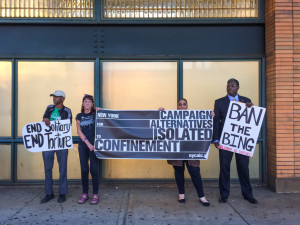By Alyssa Pagano. Reprinted from Juvenile Justice Information Exchange.
 NEW YORK — Correctional officers brought Tama Bell’s mentally ill son to the brink of suicide for throwing a rag on a table, she says.
NEW YORK — Correctional officers brought Tama Bell’s mentally ill son to the brink of suicide for throwing a rag on a table, she says.
Bell’s son, Masai, was at Mid-State Correctional Facility in Marcy, N.Y., in 2014 for a psychiatric evaluation and had gotten a job there. Inmates and officers were making fun of him when he was cleaning tables and told him to redo it, she said. He grew resentful of their prodding, threw the rag on the table and walked away.
The officers then made the other inmates leave the room. They beat him up, Bell said, and sent her son to solitary confinement for 23 hours a day at Auburn Correctional in Auburn, N.Y. He stayed there, wallowing for three months. By the time he entered his second month of 23-hour-a-day solitary, he started talking about suicide, she said.
Masai has bipolar disorder with psychotic features, but he had never talked of ending his life before. That is why Bell was one of about 15 organizers who took to the streets Wednesday hoping to draw attention to this practice so they could help hasten its end across the state.
“I believe that even if you weren’t mentally ill when you went in, you will be when you get out,” Bell said.
Inmates in solitary confinement often spend 23 hours a day alone in their cells, so the New York Campaign for Alternatives to Isolated Confinement (CAIC) holds rallies on the 23rd of each month to draw attention to that number, which they call state-sanctioned torture.
Late Wednesday afternoon, a small crowd gathered outside the Gun Hill Road subway station, near the intersection of White Plains Road, a major commercial stretch in the Bronx. They held large painted signs and used a megaphone to send a message to residents heading to the train during rush hour, but one they also hope will reach the state house in Albany.
As the sun set Wednesday evening, they passed around the megaphone, enthusiastically chanting and sharing their stories with whoever would listen. Their chants competed with the sound of trains intermittently clanking on the tracks overhead and the hiss of buses unloading passengers. The group passed out flyers and tried to talk to people.
Many of the members out that day had experienced isolated confinement themselves when they were incarcerated. The protesters said it was an unjust practice. They warned about the harm isolation can have on an inmate’s mental health.
“It was torture, ultimately,” said Craig Williams, a 33-year-old campaigner and former inmate. He spent eight and a half years in prison, three months in solitary.
“One thing I hated the most [about solitary] was only having three showers in a week.” He described how demoralizing it felt to smell his own stench and have no control over it.
Once Williams got out of solitary, he joined the Bard Prison Initiative. He read Plato’s “The Republic” and studied anthropology, giving him a more critical perspective on his situation.
“That helped me understand the whole structure and helped expose me to the conditions I was in,” he said. He thought about how to work within the system and stay out of solitary.
“It’s hard to avoid,” Williams said. “I would just dodge the officers. They pick and choose what they want to do.” They might give you a ticket if your shirt isn’t tucked in, he said, or they might untuck your shirt and then give you a ticket for not having your shirt tucked in. Williams now works as the outreach manager forPhoto Patch Foundation, an organization that connects children to their incarcerated parents through photo sharing and letter writing.
While walking to his train, Jimmy Jackson passed by the rally and took a flier. He was once incarcerated himself, back in the 1980s.
“There’s some people who have to be separated” from the rest of the prison population, Jackson said. “They can be a danger.”
Jack Beck, director of the Prison Visiting Project for the Correctional Association of New York, agrees to an extent.
“You can separate people if there’s security need, but you don’t need to isolate them,” he said.
This is largely the difference CAIC seeks to define through supporting the Humane Alternatives to Long-Term Solitary Confinement Act.
The protesters said they see the HALT Act as a comprehensive bill that would go a long way toward changing the system. It would limit the amount of time an inmate can spend in isolated confinement to no more than 15 consecutive days, and no more than 20 days total in a 60-day period.
The HALT Act would also provide alternatives to isolated confinement, such as therapeutic rehabilitation. It is now with a state Senate committee.
The organizers of Wednesday’s event called on Gov. Andrew Cuomo and the state’s acting commissioner of the Department of Corrections, Anthony J. Annucci, to support the legislation.
“They have the power and authority to turn away from the torture of solitary confinement and move towards more effective and humane approaches right now,” said Jared Chausow, campaign coalition member.
Masai was originally incarcerated for violating a felony probation, Bell said. That meant he was supposed to attend regular mental health appointments, and he did not comply. After two and a half years of incarceration, her son came home this year on Sept. 4. The prison, she said, provides minimal mental health support for this transition, and Tama continues seeking better treatment for her son.
Follow the #HALTsolitary Campaign